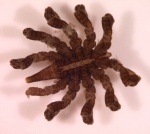 Pentapycnon geayi
Pentapycnon geayi
Photo Ingo Wehrtmann

Colossendeis cucurbita
Photo Tin-Yam Chan
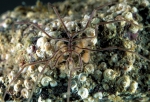
Nymphon gracile
Photo Richard Lord

Pycnogonum litorale
Photo Richard Lord
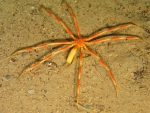
Colossendeis proboscidea
Photo Andrew Gates
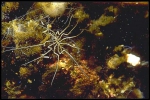
Pentanymphon antarcticum
Photo Kathy Conlan
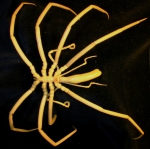
Colossendeis australis
Photo Claudia Arango
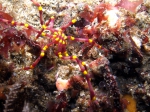
Meridionale harrisi
Photo Claudia Arango
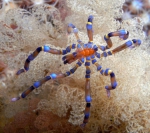
Anoplodactylus evansi
Photo M Harris |
|
PycnoBase: World Pycnogonida Database
by
Roger N. Bamber†; Aliya El Nagar & Claudia P. Arango
Introduction
The Pycnogonida, or sea-spiders, is a distinct Class of the Arthropoda which phylogenetic position is still debated (a history of the discussion in Dunlop & Arango, 2005), with recent analyses suggesting sea spiders are sister group to all extant chelicerates (a review of Arthropoda phylogenetics in Giribet and Edgecombe, 2013). Pycnogonids are almost exclusively free-living, errant marine invertebrates, found from the poles to the tropics and from the littoral zone to the deepest sea. They range in size from littoral and interstitial species with leg spans of a few mm up to the large, deep-sea colossendeids, with leg spans up to 750 mm. Some species are parasitic, like Nymphonella tapetis which lives in bivalves. Sexes are almost invariably separate and dimorphic, although gynandromorphs have been recorded.
The sea spiders characteristic body form involves a cephalon and trunk comprising four body segments, each of which bears a pair of walking legs. In addition, the cephalon bears an anterior triradiate proboscis, and primitively a pair of chelifores, a pair of palps, and a pair of ovigerous legs (ovigers), these last being a feature exclusive to the Pycnogonida. Dorsally, the cephalon primitively bears an ocular tubercle with four eyes. Variations on this theme include atrophy or loss of chelifores, o palps and/or ovigers, and, particularly in deeper water forms, loss of eyes and even of the ocular tubercle. Further, there are six polymerous species known, four having five pairs of legs and two having six pairs.
These relatively simple creatures with relatively small bodies and long legs, have gut diverticula extending into chelifores and along the legs, and the last trunk segment bears a small abdomen with a distal anus. Sea spiders lack respiratory organs or structures, and gas exchange occurs through the cuticle; recently Woods et al (2017) demonstrated how sea spiders use gut movements for internal transport of oxygen.
Where reproduction is known, the male carries the eggs attached to the ovigers, whence they hatch either as a protonymphon larva or as an advanced postlarva. A review of the different pathways of postembryonic development in Pycnogonida is found in Brenneis et al. (2017). Pycnogonids have no active dispersal ability, but some taxa, for example species of Anoplodactylus and Bathypallenopsis, are passively dispersed by medusa, achieving wide geographical distributions. The Antarctic species Nymphon australe is known as circumpolar, however, it is yet not clear what dispersal mechanisms are involved.
Feeding is generally understudied, but appears to be restricted to sessile animals and, occasionally, algae: certain species from epizoic communities on rocks or algae are known to feed on bryozoans, cnidarians and filamentous algae. The diet of the many species collected from soft sediments is unknown. The biology of sea-spiders is markedly understudied. The most recent comprehensive review of their biology is by Arnaud & Bamber (1987). Extensive bibliographies are to be found in Fry & Stock (1978) and Nakamura & Child (1991).
The fossil record is still sparse (only four pycnogonid fossil records where known by early 2000s) but new forms have described in recent years. So far, there is one known species from the Upper Ordovician (ca. 450 Ma), one from the Lower Silurian (ca. 425 Ma), five from the Lower Devonian Hunsrück Slate (Germany) (ca. 400 Ma), and three from the Jurassic (150 Ma).
PycnoBase is based on Bamber’s (2007) attempt of a holistic interpretation of the Pycnogonida classification, with subsequent amendments: notably, Nymphonella moved to the Ascorhynchidae, Pycnofragilia added to the Ascorhynchidae, and Pycnosomia added to the Phoxichilidiidae. However, these and other groupings are yet to be tested under a robust and comprehensive phylogenetic approach, in a follow up to the phylogeny in Arango & Wheeler (2007).
It is evident from recent surveys, both from shallow waters and particularly in the deep sea, that numerous species of pycnogonid await discovery. At the same time, molecular analyses are indicating the existence of cryptic species in what had been thought to be widespread taxa. This database must therefore be a working document and it will certainly continue expanding, hopefully contributing to a better understanding of the world’s pycnogonids.
Editorial Team:
Editors [tree]
CitationUsage of data from the World Pycnogonida Database in scientific publications should be acknowledged by citing as follows:
- Bamber, R.N.; El Nagar, A.; Arango, C.P.; Sabroux, R. (Eds) (2025). Pycnobase: World Pycnogonida Database. Accessed at https://www.marinespecies.org/pycnobase on 2025-12-20. doi:10.14284/360
If the data from the World Pycnogonida Database constitute a substantial proportion of the records used in analyses, the chief editor(s) of the database should be contacted. There may be additional data which may prove valuable to such analyses.
Individual pages are individually authored and dated. These can be cited separately: the proper citation is provided at the bottom of each page.
Feedback
The site welcomes input from colleagues and visitors who detect errors or omissions. Note that sadly, Roger Bamber passed away in February 2015 and Aliya El Nagar who played a key role developing the database is no longer associated to the maintenance of PycnoBase. The current editor strives to maintain the website as both a comprehensive and an up-to-date resource through regular updates.
Acknowledgements
We are very grateful to David Staples, Franz Krapp and Yoshie Takahashi for discussions and input (and thereby improvements).
References
- Arango CP, Wheeler WC. 2007. Phylogeny of the sea spiders (Arthropoda, Pycnogonida) based on direct optimization of six loci and morphology. Cladistics, 23:1–39.
- Arnaud F & Bamber RN. 1987. The Biology of Pycnogonida. Advances in Marine Biology, 24: 1-96.
- Bamber, RN. 2007. A holistic re-interpretation of the phylogeny of the Pycnogonida Latreille, 1810 (Arthropoda). In: Zhang, Z.-Q & Shear, W.A. (Eds): Linnean Tercentenary. Progress in invertebrate taxonomy. Zootaxa, 1668: 295-312.
- Brenneis, G, Bogomolova, E, Arango, CP, Krapp, F. 2017. From egg to “no-body”:an overview and revision of developmental pathways in the ancient arthropod lineage Pycnogonida. Frontiers of Zoology, 14:6. DOI 10.1186/s12983-017-0192-2
- Dunlop JA, Arango CP. 2005. Pycnogonid affinities: a review. Journal of Zoological Systematics and Evolutionary Research, 43:8–21.
- Fry WG & Stock JH. 1978. A pycnogonid bibliography. In, Sea Spiders (Pycnogonida). Zoological Journal of the Linnean Society of London, 63 (1 + 2): 197-238.
- Giribet G, Edgecombe GD. The Arthropoda: A Phylogenetic Framework. In: Minelli
- A, Boxshall G, Fusco G, editors. Arthropod Biology and Evolution Molecules, Development, Morphology. Heidelberg: Springer Verlag; 2013. p. 17–40.
- Nakamura K. & Child C.A. 1991. Pycnogonida from waters adjacent to Japan. Smithsonian Contributions to Zoology, 512: 74pp.
|